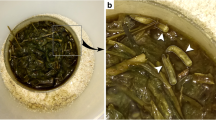Abstract
The development of immature tiger-fly Coenosia attenuata (Stein) was examined when reared in coir substrate and fed third-instar larvae of the fungus gnat Bradysia impatiens (Johannsen). Single larvae of C. attenuata were fed 3, 5, 7 and 9 prey per day and two larvae were fed 6, 10, 14 and 18 prey per day. Optimal prey density was determined for larval developmental rate, time to adult eclosion, larval survival, and percentage of pupation. Other biological characteristics, such as pupal weight, pupal length, and adult body length, continued to increase with an increase in prey density. The use of coir for a rearing substrate resulted in a more efficient use of prey, less cannibalism, and improved developmental time, and survival than previously reported when agarose gel or a mixture of soil and coir were used for rearing substrates. These improvements in rearing methods are significant advancements for the use of C. attenuata as a biological control agent against whiteflies, leaf miners, fungus gnats and winged-aphids. Additionally, coir substrate serves as a mulch layer when fungus gnats are controlled with C. attenuata, such as Bradysia odoriphaga (Yang et Zhang) in Chinese chive, and B. impatiens in potted ornamental plants.

Similar content being viewed by others
References
Cock, M. J. W. (1993). Bemisia tabaci: an update 1986–1992 on the cotton whitefly with an annotated bibliography. Ascot, UK: CAB International Institute of Biological Control, 78.
Gerling, D., Alomar, O., & Arn, J. (2001). Biological control of Bemisia tabaci using predators and parasitoids. Protection, 20, 779–799.
Gilioli, G., Baumgärtner, J., & Vacante, V. (2005). Temperature influences on functional response of Coenosia attenuata (Diptera: Muscidae) individuals. Journal of Economic Entomology, 98(5), 1524–1530.
Hennig, W. (1964). Muscidae. In E. Lindner (Ed.), Die Fliegen der Palaearktischen Region (pp. 7(2) Erste Hälfte). Stuttgart: Schweizerbart’sche Verlagsbuchhandlung.
Kühne, S. (2000). Räuberische Fliegen der Gattung Coenosia Meigen, 1826 (Diptera: Muscidae) und die Möglichkeit ihres Einsatzes bei der biologischen Schädlingsbekämpfung. Studia Dipterologica, 9(Supplement), 78.
Kühne, S., Schiller, K., & Dahl, U. (1997). Beitrag zur lebensweise, morphologie und entwicklungsdauer der räuberischen fliege Coenosia attenuata Stein (Diptera: Muscidae). Gesunde Pflanzen, 49(3), 100–106.
Li, H. J., He, X. K., Zeng, A. J., Liu, Y. J., & Jiang, S. R. (2007). Bradysia Odoriphaga copulatory behavior and evidence of a female sex pheromone. Journal of Agricultural and Urban Entomology, 24, 27–34.
Martinez, M., & Cocquempot, C. (2000). La mouche Coenosia attenuata nouvel auxiliaire prometteur en culture protégée. PHM-Revue Horticole, 414, 50–52.
Martins, J., Mateus, C., Ramos, A., & Figueiredo, E. (2015). An optimized method for mass rearing the tiger-fly, Coenosia attenuata (Diptera: Muscidae). European Journal of Entomology, 112(3), 470–476.
Mei, Z. X., Wu, Q. J., Zhang, Y. J., & Hua, L. (2003). The biology, ecology and management of Bradysia Odoriphaga. Entomological Knowledge, 40, 396–398.
Moreschi, I., & Colombo, M. (1999). Una metódica per l’allevamento dei Ditteri predatori Coenosia attenuata e C. strigipes. Informatore Fitopatologico, 49, 61–64.
Moreschi, I., & Süss, L. (1998). Osservazioni biologiche ed etologiche su Coenosia attenuata Stein e Coenosia strigipes Stein (Diptera Muscidae). Bollettino di Zoologia Agraria e di Bachicoltura, 30(2), 185–197.
Morris, D. E., & Cloutier, C. (1987). Biology of the predatory fly Coenosia tigrina (Fab.) (Diptera: Anthomyiidae): reproduction, development, and larval feeding on earthworms in the laboratory. The Canadian Entomologist, 119, 381–393.
Parrela, M. P. (2008). Biological control in protected culture: will it continue to expand? Phytoparasitica, 3, 3–6.
Pohl, D., Kühne, S., Karaca, İ., & Moll, E. (2012). Review of Coenosia attenuata Stein and its first record as a predator of important greenhouse pests in Turkey. Phytoparasitica, 40, 63–68.
Sanderson, J., Ugine, T., Wraight, S., & Sensenbach, E. (2009). Something for nothing: the beneficial hunter fly may be helping you manage pests. Grower Talker, 73(6), 74–76.
Seabra, S. G., Brás, P. G., Martins, J., Martins, R., Wyatt, N., Shirazi, J., et al. (2015). Phylogeographical patterns in Coenosia attenuata (Diptera: Muscidae): a widespread predator of insect species associated with greenhouse crops. Biological Journal of the Linnean Society, 114(2), 308–326.
Sensenbach, E. J., Wraight, S. P., & Sanderson, J. P. (2005). Biology and predatory feeding behavior of larvae of the hunter fly Coenosia attenuata. IOBC/wprs Bulletin, 28(1), 229–232.
Tellez, M. D. M., Tapia, G., Gamez, M., Cabello, T., & Vanemden, H. (2009). Predation of Bradysia sp. (Diptera: Sciaridae), Liriomyza trifolii (Diptera: Agromyzidae) and Bemisia tabaci (Hemiptera: Aleyrodidae) by Coenosia attenuata (Diptera: Muscidae) in greenhouse crops. European Journal of Entomology, 106(2), 199–204.
Ugine, T. A., Sensenbach, E. J., Sanderson, J. P., & Wraight, S. P. (2010). Biology and feeding requirements of larval hunter flies Coenosia attenuata (Diptera: Muscidae) reared on larvae of the fungus gnat Bradysia impatiens (Diptera: Sciaridae). Journal of Economic Entomology, 103(4), 1149–1158.
Valentini, M. (2009). Nuove tecniche per l’allevamento massal di ditteri del genere Coenosia Meigen. PhD. Thesis. Bologna: Università di Bologna.
Xue, W. Q., & Tong, Y. F. (2003). A taxonomic study on Coenoia tigrina species-group (Diptera: Muscidae) in China. Insect Science, 10(4), 281–290.
Zou, D. Y. (2015). Current research status of key natural enemies in Tianjin. China Rural Science and Technology, 10, 38–39.
Acknowledgements
We thank Professor Wan-Qi Xue (Shenyang Normal University, China) for helping in species identification. This work was partially financed by the project Special Fund for Agro-scientific Research in the Public Interest (No. 201303027) and Special Foundation of President of Tianjin Academy of Agricultural Sciences (No. 14002).
Author information
Authors and Affiliations
Corresponding author
Rights and permissions
About this article
Cite this article
Zou, D., Coudron, T.A., Xu, W. et al. Development of immature tiger-fly Coenosia attenuata (Stein) reared on larvae of the fungus gnat Bradysia impatiens (Johannsen) in coir substrate. Phytoparasitica 45, 75–84 (2017). https://doi.org/10.1007/s12600-017-0564-3
Received:
Accepted:
Published:
Issue Date:
DOI: https://doi.org/10.1007/s12600-017-0564-3




